 |
Alderney
Channel Islands, UK
|
|
 |
Fortifications Constructed: 1549-1859
Used by: Great Britain, Germany
Conflict in which it participated:
Second World War
|
Alderney is the northernmost of the Channel Islands, sitting just off of France's nor'eastern tip. In the 1850's it was forged into what would have been called Great Britain's unsinkable aircraft carrier, had their been aircraft carriers (or aircraft) in the 1850's. There would eventually be eighteen forts and gun batteries (thirteen forts of which survive, in varying states of decrepitude), built on this minuscule, three-square-mile island. |
 |
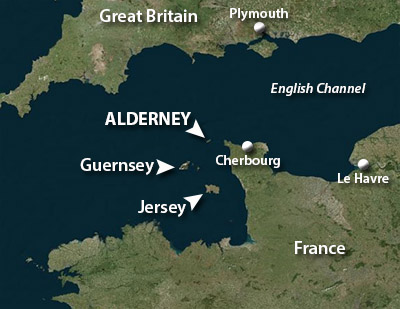 |
|
Click on any of the forts' names to skip right to that fort's information:
|
|
|
|
The Channel Islands, though today Crown Dependencies of the United Kingdom, have a lot more common history with France, or more accurately Normandy. The genesis of the name Alderney is somewhat at issue, but may be a corruption of Adreni or Alrene, which are similar to the Old Norse word meaning "island near the coast."
|
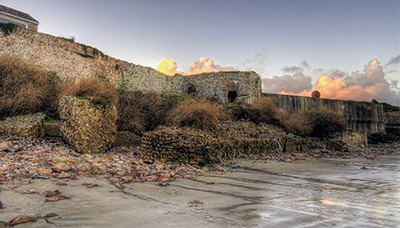 The Nunnery, Which is what those on Alderney call the remains of a Roman fort that was built to watch over Longis Bay, the island's only natural harbor, around 300AD. What did the Romans call this fort? Probably not "The Nunnery." The Nunnery, Which is what those on Alderney call the remains of a Roman fort that was built to watch over Longis Bay, the island's only natural harbor, around 300AD. What did the Romans call this fort? Probably not "The Nunnery." |
 |
Being where it is, the island of Alderney has been visited by many maritime nations through history. The Romans thought the island was important enough to build a fort there around 300AD, the remains of which have only recently been identified as being Roman in origin.
Alderney, along with the rest of the Channel Islands, was annexed by the Duchy of Normandy in 933AD. A Duke of Normandy, the aptly-named William the Conqueror (1028-1087), conquered England in 1066. Things got confusing for a while with the King of England also being the Duke of Normandy, thus a vassal of the King of France. |
|
Normandy was officially incorporated into the Kingdom of France in 1204, but the Channel Islands remained loyal to England. In the 1540's, King Henry VIII (1491-1547) directed that fortifications be built on Alderney, as part of his program to defend England from potential invasions from France or Spain, due to his break with the Catholic church.
|
King Henry's fortification effort became known as the Device Programme, as the contemporary style of fort in England was the Device Fort. Occurring in the early days of starfort technology, the Device Fort incorporated some aspects of the starfort (mutually supporting bastions), but were more rounded in execution, more castle-like. The early parts of Pendennis Castle in Falmouth, UK is a good example of this phenomenon. Planning for Castle Essex began in 1547, and work began in 1549, after the death of King Henry. Work ceased in 1554, and the fort wasn't completed for another three hundred years. |
 |
|
|
We will find that Great Britain has frequently felt threatened by France. One such happenstance occurred in the 1790's, when France's Revolution was causing a great deal of consternation amongst the crowned heads of Europe. The remarkably tiny Fort Doyle was built at a location that seems an unlikely place for the French to land in 1793, as a "response" to this threat. British gun batteries littered Alderney from 1800 to 1815, with a total of 85 guns of varying sizes on duty throughout the Napoleonic Wars (1803-1815). Even the Roman "Nunnery" was armed during this period, with two 32-pounder guns! And in the mid-19th century Great Britain felt even more endangered by France! In 1852 Napoleon III (1808-1873), who had been elected President of France in 1848, majestically declared himself to be Emperor of the Second French Empire. The First French Empire with the first Napoleon (1769-1821) had been such a pain to get rid of, the second or third of either of these entities did not bode well for Britain. Particularly as this latest Napoleon was making suggestions that it might be nice to invade Britain, while building up his military: Especially scary to Great Britain were the improvements that Napoleon III was making to his naval facility at Cherbourg, and, perhaps scariest of all to the seafaring Brits, the French launching of the world's first oceangoing ironclad battleship, the Gloire, in 1859. |
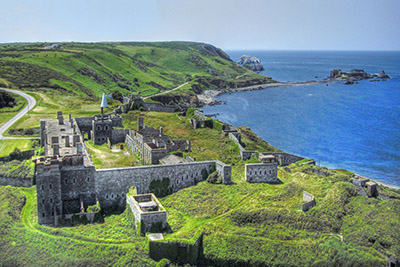 Fort Tourgis, with Fort Clonque visible in the distance. Also note the white cone on the far side of Fort Tourgis, which was a navigational aid made before light existed for a lighthouse. Thanks to Kevin Lajoie for this incredible shot from a commanding height! Visit Kevin's website, Aeriali.net! Fort Tourgis, with Fort Clonque visible in the distance. Also note the white cone on the far side of Fort Tourgis, which was a navigational aid made before light existed for a lighthouse. Thanks to Kevin Lajoie for this incredible shot from a commanding height! Visit Kevin's website, Aeriali.net! |
 |
Some bright person in the British government determined that a tiny, fortified Alderney, so close to the French coast, would be the perfect tripwire for any attack that Napoleon III might be planning. "If you wanna get to us, ya gotta get through Fortress Alderney first!" (Response in a French accent:) "No, we do not, we could just sail around Alderney, or even disembark from a completely different area...?" (Rejoinder in a fruity British accent:) "Nonsense, Fortress Alderney will be your doom, you vile, filthy Frenchman!"
Whomever came up with this plan, it was not supported by British Prime Minister William Gladstone (1809-1898), who is known, among other things, for his pithy commentary. |
|
Gladstone described the scheme of massively fortifying Alderney as "a monument of human folly, useless to us...but perhaps not absolutely useless to a possible enemy, with whom we may at some period have to deal and who may possibly be able to extract some profit in the way of shelter and accommodation from the ruins." And how right he turned out to be, although the enemy who profited from Alderney's many fortifications would not be France, but Germany, nearly a hundred years in the future.
|
To be fair, the actual plan for Alderney was to serve as a forward operating base for the Royal Navy, in the event of a war with France. A new harbor was built on the island's north side (Braye Harbor), as the island's only natural harbor, Longis Bay, was too shallow to support modern ships. The string of forts that were plopped onto Alderney in the 1850's were there to protect Braye Harbor.
One very important person who apparently was a fan of a fortified Alderney was the ever-vivacious-and-flirtatious Queen Victoria (1819-1901). She and Royal Consort Prince Albert (1819-1861) visited Alderney on August 9, 1854, to see how the fortifications were coming along.
|
 |
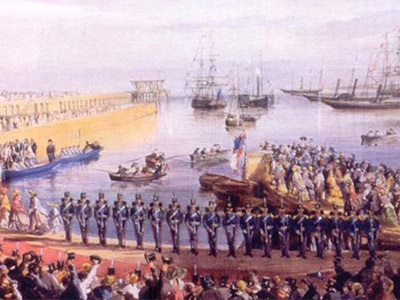 Queen Victoria and Prince Albert visit Alderney: August 9, 1854 Queen Victoria and Prince Albert visit Alderney: August 9, 1854 |
|
While there, the Queen demanded to know why none of the forts being built on Alderney were proper starforts, a question to which there is no good answer, as well as being a question that I just made up. Had the Queen actually asked this question, she would have been told that, in the futuristic 1850's, military engineers had come to the conclusion that the classic starfort design, state-of-the-art for the past three centuries, was no longer a match for modern artillery, the technology of which was advancing much faster than anyone building forts could keep up with. That being said, however, one will note below that several of Alderney's forts do indeed have starfortlike aspects.
|
|
 |
Starfortesque or not, the massive British effort on Alderney was for naught. By the 1860's, the island's new harbor was no longer big or deep enough for the latest ironclad warships. France's attention had by this point turned eastward, and the Second French Empire was soon thereafter utterly destroyed by the Prussian army in the Franco-Prussian War (1870-1871).
Added to all of this was, again, the steady advance of the technology of artillery. Designed to mount lots and lots of muzzle-loading cannon that were hopelessly outmoded by the time the 1870's rolled around, the forts of Alderney were doomed to obsolescence before they were even fully armed.
|
|
In 1886 it was decided that the focus of Alderney's defenses would be on Fort Albert, the island's largest and most recently built fort. The suggestion that Alderney might serve as a useful base for small torpedo boats was made, and Fort Albert was armed with two modern six-inch guns, two rapid-fire 12-pounder guns, and two searchlights in 1901. Though each of Alderney's forts had been blessed with a variety of armaments as early as 1859, Fort Albert was the only one in which the British bothered to put modern (breechloading) guns.
In 1940, Alderney's close proximity to France had become close proximity to Nazi Germany, as France had fallen to the Hun. Instead of facing the inevitable German occupation force with whatever 1850's vintage weaponry was still left on the island, Great Britain elected to evacuate all 1500 of Alderney's residents.
The German army arrived on the deserted island shortly thereafter. Historically willing to make use of a nice starfort when they came across one, the Nazis nonetheless spent the next four years feverishly building a dizzying array of new bunkers, air raid shelters and tunnels all over (and under) Alderney.
|
 |
|
|
All of this feverish construction was of course not undertaken by the Germans themselves, but rather by the 6,000+ slaves they brought with them, shipped in from a number of occupied nations. Four concentration camps were built on the island to hold all of these "workers," and something like 700 of them died on Alderney during the period of German occupation.
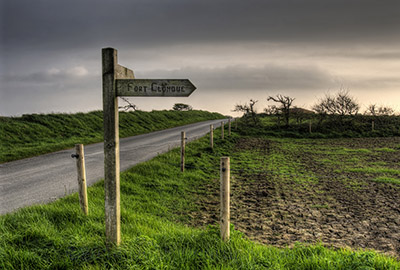 Wanna get to Fort Clonque? It's that-a-way. Wanna get to Fort Clonque? It's that-a-way. |
 |
The remaining 2500 or so Germans on Alderney surrendered on May 16, 1945. Many of their bunkers have since been repurposed by the island's populace: The Aussie BBQ Bunker today proudly operates in a German emplacement on the north end of the island.
Some of Alderney's more honorably derived forts (meaning anything the Germans didn't make) have also been repurposed, some into apartment flats, and Fort Clonque into a "comfortable self-catering accommodation for up to 13 persons," which sounds like a vacation cabin to me.
|
|
The British forts on Alderney are a weird and wonderful cornucopia of fortification styles, from the modern polygonal majesty of Fort Albert to the downright medieval castleishness of Fort Houmet Herbé. Even the names of these forts are a strange mishmash, no doubt owing to the island's Norman roots. Please read on to learn more specific information about the forts of Alderney!
|
|
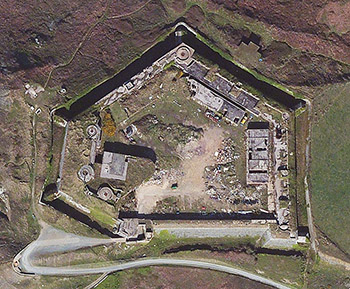 |
 |
Fort Albert was originally named Fort Touraille, but was renamed in honor of Queen Victoria's "Prince Consort," Albert, upon his death in 1861. Surely the Queen was greatly consoled by this act.
It was the last fort to be built on Alderney, and thus the most modern in style: Polygonal forts, also known as "flankless forts," first appeared at the end of the 18th century and were built with rapid glee all over the UK in the 19th century. Many of the Palmerston Forts, built to defend Britain's strategic harbors in the 1860's, were polygonal forts. |
|
|
When Fort Albert was completed in 1859, it was armed with twenty six 68-pounder guns, and seventeen 8" guns. The largest of the forts on Alderney, it was intended to be the island's citadel, to which the island's defenders would retreat if the other forts were overrun by marauding Frenchmen.
|
In the plan to the right, we see that instead of the classic starfort bastion, Fort Albert has five caponiers, which absolutely were bastions, if not as pronounced and lovely as the starfort type. Fort Albert also had a cavalier, essentially a raised, fortified firing position atop the already raised, fortified firing position of the fort itself. A defensive cavalier has a ditch around it, even though it's already atop a stoutly defended fort, which is what it looks like Fort Albert's might be. It sure seems as though the authorities were expecting things to go very badly on this island! The British, however, have always been masters of the fighting retreat, and the redoubt. Just ask Lieutenant John Chard (1847-1897) of the Royal Engineers about his experience at Rorke's Drift in Natal Colony in 1879.
In 1886, the decision was made to do away with the obsolete guns with which Alderney's forts had been armed in the 1850's. Fort Albert was rearmed with two 6" guns, two rapid-fire 12-pounder guns, and a pair of searchlights in 1901. |
 |
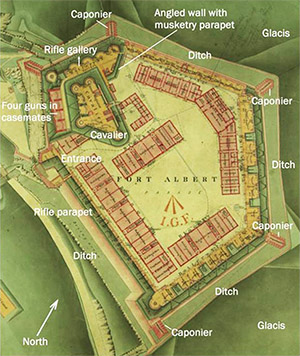 |
|
To accomplish this rearmament, Fort Albert's cavalier was lowered nearly 12 feet (why put your guns way up in the air for everyone to see and shoot at?). Braye Harbor, that which the British had worked so hard to construct through the 1850's, and over which Fort Albert sat, was unfortunately too shallow to permit the entrance of the ironclad fighting ships that started appearing in the 1860's. Fort Albert was the only of Alderney's forts to be armed with modern guns at this time.
|
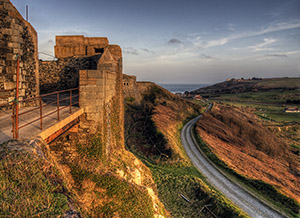 Fort Albert's southwestern wall, near its main gate. Fort Albert's southwestern wall, near its main gate. |
 |
Fort Albert's guns were long gone by the time the Germans showed up on Alderney in 1940, during the Second World War (1939-1945). No doubt the Nazis enjoyed touring the dilapidated fort, but didn't bother trying to fortify or rearm it: They concentrated their slaves' efforts on building new concrete bunkers all over the island instead.
In 2012, the UCP (Up Close & Personal) Group, an enterprise that provides bodyguards to the rich, famous and/or royal, was granted permission to use Fort Albert for the training of recruits. Any discharge of firearms requires vast amounts of licensing and permissions in Great Britain, but it is legal to fire live rounds on Alderney on certified ranges.
|
|
The UCP Group reported plans to open Fort Albert for corporate "team building exercises" and tourism over the next few years, but I don't see anything specific about the fort at their website, and frankly touring a fort while people are shooting at me doesn't sound terribly appealing. But that's just me.
|
|
Fort Clonque is Alderney's easternmost defense, which in 1859 was armed with seven 68-pounder guns, two 32-pounders and one 8" gun. It was designed to be garrisoned by two officers and 50 men. As is true of most of Alderney's forts, Fort Clonque is an odd shape indeed: This was necessitated by its location, jammed as it is atop a pile of rocks. This fort spent a relatively brief period as a military fortification: In 1886 it was decided to essentially give up on all but one of Alderney's forts, Fort Albert, and Fort Clonque was left to rot. |
 |
|
|
Many of Alderney's forts were repurposed, however, and Fort Clonque may have received the most successful repurposing of them all!
|
|
 |
Today Fort Clonque is one of Alderney's leading attractions, as a "comfortable self-catering accommodation for up to 13 persons." According to many overjoyed reviews at Tripadvisor.com, an evening at Fort Clonque is a treat indeed, if a slightly rugged experience. The causeway by which one reaches the fort is flooded at high tide, so make sure to stock up on Twinkies and Mountain Dew (or their Alderneyan equivalents) when you can!
Fort Clonque was damaged during heavy storms in 2014, but probably not very much, because...it's a big rock.
|
|
Book your exciting vacation at Fort Clonque here! |
|
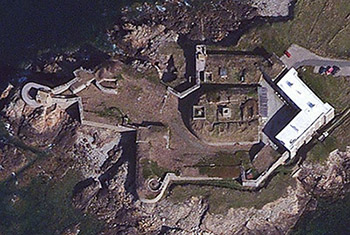 |
 |
Alderney's northernmost fortification, Fort Corblets was armed with five 32-pounder guns, three 24-pounders and five 8" guns in 1859. This fort enjoys some particularly starry elements on its landward side, and has a cavalier, or raised gun position, watching over everything. Like Fort Clonque, Fort Corblets is available for rental as a "self-catering accommodation." Also like Fort Clonque, Fort Corblets' quarters are described as "...a world of their own to be enjoyed for their own sake and not to be compared to more conventional accommodation." Which likely means, bring your own heating and air conditioning. |
|
|
 Fort Corblets from the ground, with a Nazi control bunker visible to the right Fort Corblets from the ground, with a Nazi control bunker visible to the right |
|
In the early 1790's, the French Revolution was making everybody in every other nation of Europe extremely uneasy. Britain's King George III (1738-1820) was so uneasy that he sent 300 men to Alderney to build a fort that was so teeny, surely nobody could have considered it capable of defending the entire island. But build it they did.
This fort was named after Sir John Doyle (1756-1834), a British Army officer who had served with distinction in the American Revolutionary War (1775-1783), and who would go on to serve with equal distinction in the Napoleonic Wars (1803-1815). |
 |
|
|
Doyle, an Irishman, served as Lieutenant Governor of Guernsey from 1803 to 1816, which doesn't quite jibe with Fort Doyle being named after him in 1793. Perhaps at the time of its construction, the fort was known as "Fort Way Too Tiny To Be Of Any Use Whatsoever." But probably not. In 1859 Fort Doyle was armed with one 8" howitzer and three 8" guns. |
|
Castle Essex was Alderney's first British fortification, whose construction was ordered by King Henry VIII in 1547. King Henry had enraged the Catholic church by creating the Church of England in order to marry someone other than the person to whom he was presently married, Catherine of Aragon (1485-1536). Catherine seemed intransigently determined not to provide Henry with a male heir, so in 1527 he asked Pope Clement VII (1478-1534) to grant an annulment of this marriage. |
 |
|
|
The Pope, likely jealous that he was only the VII while Henry was the VIII, said heck no you selfish twit, so Henry proclaimed himself head of the new Church of England, which was of the Protestant persuasion. Infuriating the Catholic church meant infuriating France and Spain, so we have now come back to Henry needing to fortify his domain from what he considered imminent attack. Way to go, Henry.
Castle Essex was named for Thomas Cromwell (1485-1540), Earl of Essex. Cromwell aided Henry greatly in his heroic start-a-new-church-so-I-can-do-whatever-I-want thing. Unfortunately he helped Henry too much, bringing some of Henry's subsequent annulments and marriages to fruition, which naturally caused Henry to hate him and thus Cromwell was beheaded in 1540. But his name lives on in this fort. Sort of.
|
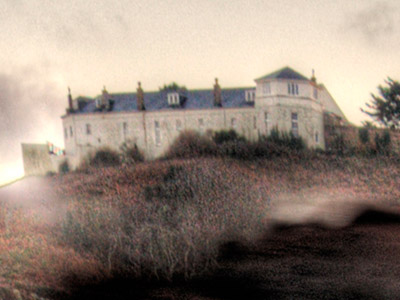 The photographer says that this shot of Castle Essex from Longis Bay was a mistake, but it seems more likely that the fort moves so fast, it's difficult to capture in a conventional photograph. The photographer says that this shot of Castle Essex from Longis Bay was a mistake, but it seems more likely that the fort moves so fast, it's difficult to capture in a conventional photograph. |
 |
Work on this castle overlooking Alderney's only natural harbor at Longis Bay commenced in 1549. By 1553 a whopping £9210 had been spent on this endeavor, but Henry died that year, and once Mary I (1516-1558) was properly enthroned and crowned and sceptered into Queenhood, she brought Roman Catholicism back as England's official worship system.
Catholicism was appeased, attack was averted, and there was no longer an immediate need for a cool castle on Alderney. Queen Mary stopped the fortification's construction in 1554.
The castle was ordered razed, but was instead disassembled in an orderly, gentlemanly manner. |
|
|
Fast forward to the period of our current interest, namely the mid-18th century. Fort Essex was built atop the remains of the castle. Although the Castle Essex we see today is arguably the most starfortish in appearance of Alderney's forts, it was never armed, serving instead as the island's military hospital.
|
|
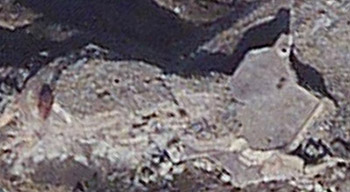 |
 |
If anyone other than me finds it ironic that many of the forts built to defend Alderney from the French have extremely French names, I have yet to see any evidence of it. This fort's name translates to Castle of the Stack, likely due to the stack of rocks 'pon which 'twas constructed. Doesn't look like much from the air today, does it? |
|
|
Fort Château à l'Étoc was built at what would have been where the eastern arm of Braye Harbor's breakwater met the shore. This breakwater was never completed, but by 1859 this fort was armed with five 32-pounder guns, three 24-pounders and five 8" guns anyway.
During the Second World War, the Nazis built a 20mm anti-aircraft position at the Château, and dug a series of bunkers around it.
Today, this fort is used as private apartments. |
 |
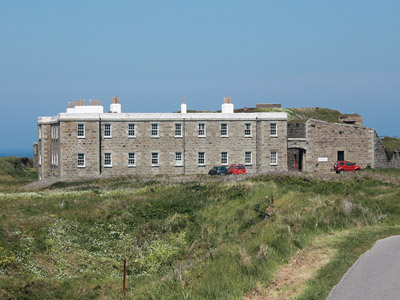 |
|
|
Waaaaay out on Alderney's rocky nor'eastern tip is Fort Les Hommeaux Florains, which translates (very) loosely as "Fort of the Florains Dudes." This fort holds the much sought-after distinction of being Alderney's most dilapidated fortification, the causeway by which one would approach it having been long ago swept away by the ocean.
In 1859, this fort was armed with three 68-pounder guns, and four 32-pounders. |
 |
|
|
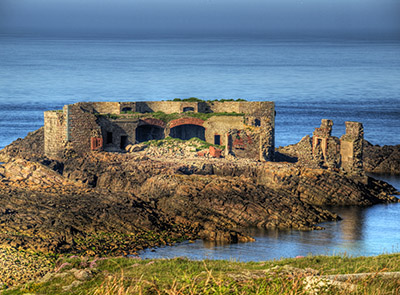 |
 |
As we see to the left, the fort that those Florains Dudes built was a casemated, three-gun platform. Were there gun ports opening from the casemates? Doesn't look like it here, but hopefully someone who's seen it in person might let us know.
Fort Les Hommeaux Florains was built to watch over Cat's Bay, one of Alderney's many teeny tiny bays that sure don't seem as though they would need defending, but all I'm doing is looking at the map, not standing there in 1850, biting my nails to the quick because a French ship might conceivably land there. |
|
|
|
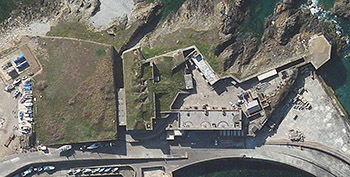 |
 |
"Grosnez" comes from the old Norse words for "grey headland:" grar nes. There is also a Castle Grosnez on nearby Jersey Island, which dates back to the 14th century. That was before there were starforts, however, so we don't care about that Grosnez.
One of the coolest things about starforts in general, and the forts on Alderney in particular, is that each and every one is different. Fort Grosnez might be the differentest of them all! |
|
|
Many starforts were built with the protection of a surrounding earthen slope, to prevent the fort's walls from being exposed to direct fire. Fort Grosnez has its very own slice of a slope, protecting its landward approach! Built at the western edge of Braye Harbor, Fort Grosnez was the third most heavily armed fort on the island, after only Fort Albert and Fort Tourgis. In 1859, Fort Grosnez was armed with two 8" howitzers, six 68-pounder guns, sixteen 32-pounders, and four 24-pounders. Fort Grosnez sits at the start of Alderney's Western Breakwater, which extends 1600 yards from the shore, and is the longest breakwater in the United Kingdom. |
 |

Fort Grosnez watching o'er Alderney's manmade harbor: Check out that weird slope to the fort's left! |
|
By 1893, all but one ( Fort Albert) of Alderney's forts had been stripped of operational ordnance. Fort Grosnez, however, still proudly mounted two "practice guns," which Alderney's militia got to play with. |
|
This fort's name translates as grassy islet. Islet, yes. Grassy? Where? Today all the islet's grass seems to be in the fort itself.
One wonders at the thought process of the engineers building forts on Alderney in the 1850's. Each spot that was selected upon which to build a fort presented its own topographical challenges, as many of these locations were little more than piles of rocks surrounded by a nasty sea. But were these engineers also competing with one another to come up with the most amusing fort design? |
 |
|
|
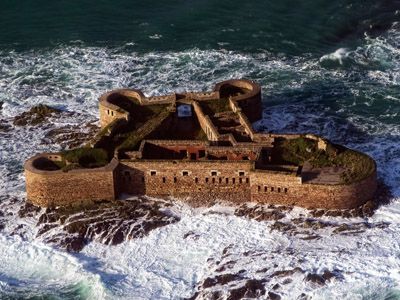 Oh, that's why there's no grass left on the grassy islet! Oh, that's why there's no grass left on the grassy islet! |
 |
Because Fort Houmert Herbé is most definitely amusing. While it certainly makes a degree of sense to dispense with the standard starfort design for a fort on a tiny island that is unlikely to be attacked by dudes with muskets and field pieces, this fort looks a bit like a crusader's castle from the 1400's. While it has four bastions, they're rounded off in a manner that harkens back to the device forts of Britain's 16th century.
One accesses Fort Houmert Herbé via a causeway that is only accessible at low tide. In 1859, this most easternmost of Alderney's forts was relatively lightly armed with one 8" howitzer and nine 8" guns. |
|
|
|
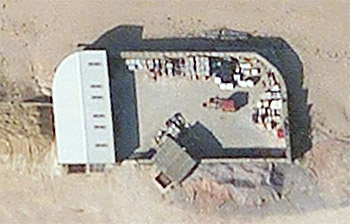 |
 |
So little fortishness is left of this fort, I'm almost loathe to include it here... But it's a fort on Alderney, so here we go. This small fort was really the center point of a defensive battery, which in 1859 mounted five 68-pounder guns. 'Twas sited to defend Saline Bay, which was also very well covered by Fort Tourgis, but the one thing Alderney had going for it in the 1850's was that every square foot of any site upon which an enemy might potentially land was definitively covered by all manner of artillery. |
|
|
Today, Fort Platte Saline is "used in connection with the gravel industry."  Hooray for the gravel industry! Fort Platte Saline in a postcard from the days before the world was in color. Hooray for the gravel industry! Fort Platte Saline in a postcard from the days before the world was in color. |
|
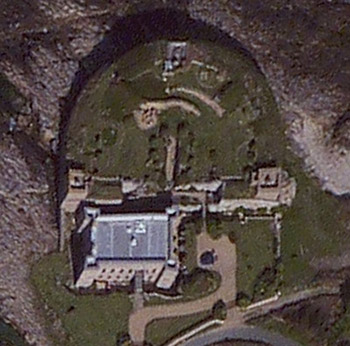 |
 |
Fort Quesnard defends a teeny portion of Alderney's eastern tip. In 1859 this little fort was armed with three 32-pounder guns, and four 8" guns.
This fort was surely named after someone, and even as distinctive as the word "Quesnard" is, the Internet proves unhelpful in the attempt to glean its origin. There is a Quesnard Point on Alderney, where a lighthouse was built in 1912.
A thoroughly refurbished Fort Quesnard was recently put on the market as a luxury home at the cost of £3.15 million (nearly $5 million). Turns out Alderney is a tax haven, if not quite as fast-paced as the "jet set" might choose.
|
|
|
|
|
When I first saw the name of this fort, I was confused that such a place as RAT ISLAND would be fortified! I mean, It's already covered with rats, right? Who's gonna try to invade that island?!
Oh, you (me) foolish English-speaker. The body of water to Alderney's east is called The Race, and that explains this fort's name. |
 |
|
|
On an island guarded by lots of little fortlets extending out in an unlikely fashion from the shore, Fort Isle de Raz extends the furthest. Built to protect Longis Bay, Alderney's only natural harbor (this fort extends directly into the center of that bay!), Fort Isle de Raz was armed with eight 68-pounder guns and two 8" guns in 1859. It can only be reached by a causeway at low tide.
|
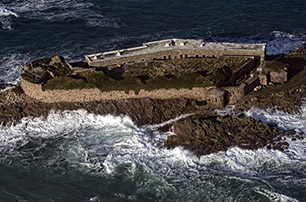 |
 |
Fort Raz was heavily armed in order to protect Castle Essex at the other side of Longis Bay, as that fort was never armed, but was instead used as the island's military hospital. The Nazis who came to Alderney during the Second World War took a shine to Fort Isle de Raz, and built many bunkers in and around it. Since the war the fort has operated as a private residence, a bird museum (?!) and a restaurant, is currently unoccupied but undergoing renovation!
|
|
|
To be what, exactly? I have no idea! This despite the fort having its very own Facebook page, which is long on cool pictures of the renovation process, but short on any information about what the fort is being renovated into. |
|
|
|
|
|
At one point, Fort Isle de Raz was home to a bird museum. The walls and ceiling for the portion of the fort that was used for this museum were painted black, as is only proper for a bird museum.
|
|
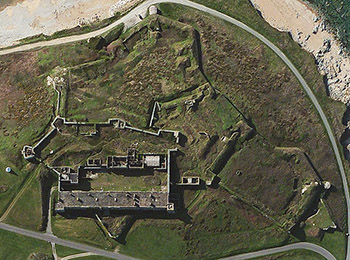 |
 |
When Fort Tourgis was completed, it was Alderney's crown jewel, its largest fort, its citadel of citadels. The fort surely stuck out its lower lip in dejection the following year, when work on the larger and (arguably) cooler Fort Albert (then named Fort Touraille) was begun. Fort Tourgis was designed to be garrisoned by 346 men. In 1859 it was armed with eight 68-pounder guns, ten 32-pounders and fifteen 8" guns. |
|
|
This fort also mounted four 13" mortars, and was the only fortification on Alderney to utilize such monst'rous weapons of war. The idea of heavy mortars used in an antiship capacity was to drop huge shells down onto the unarmored decks of attacking ships. This concept was much embraced by the US Army during its Endicott Period of fortification. Were mortars accurate enough in 1859 to successfully be dropped on a moving, relatively tiny ship's deck? I am making a skeptical face right now. |
Fort Tourgis was located to protect Alderney's new harbor (Braye Harbor), or more precisely its awesome new breakwater, which seems to have been felt to need more protection than the harbor itself. It was the longest breakwater in the UK, after all, and thus an object of British pride. No doubt Napoleon III seethed with jealousy over this edifice, and made dark plans for its defacement...only to by foiled by the imposing visage of Fort Tourgis!
The Germans who took possession of Alderney during the Second World War were very impressed by Fort Tourgis, renaming it Stutzpunkt Türkenburg, or Strongpoint Turk's Castle. |
 |
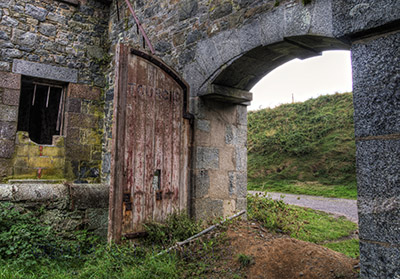 Fort Tourgis' main gate Fort Tourgis' main gate |
|
In addition to giving this fort a way cooler name than Fort Tourgis, the Nazis built a number of gun positions therein. The Stutzpunkt of our current interest was used by the Germans as their main ammunition magazine on Alderney.
|
|
|
To Fort Tourgis' immediate south stands a white, conical marker that was once used as a navigational aid to seafarers trying to sail through the treacherous waters of The Swinge, which is the absolutely delightful name for the waterway to Alderney's northwest.
|
|
Infinite thanks to starfort watcher extraordinaire Gareth Hill, for alerting us to the regal existence of Alderney. Many of the wonderful pictures on this page come to us courtesy of photographer Neil Howard, whose Flickriver page is a ridiculously wonderful archive of his visit to Alderney.
|
|
|
|
|
| |
|
 |





